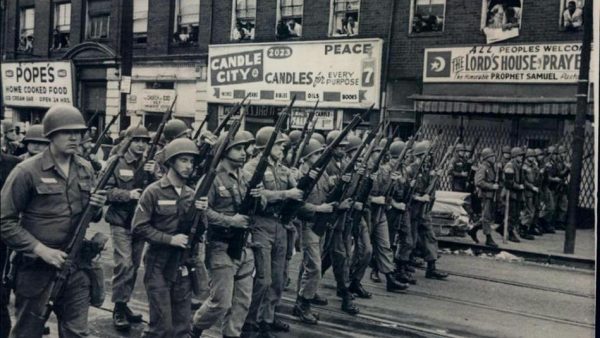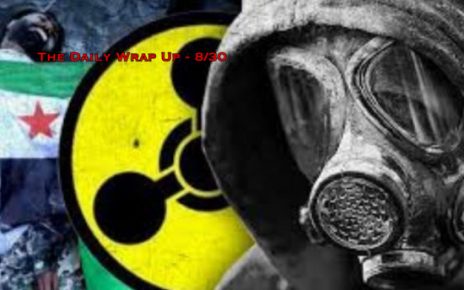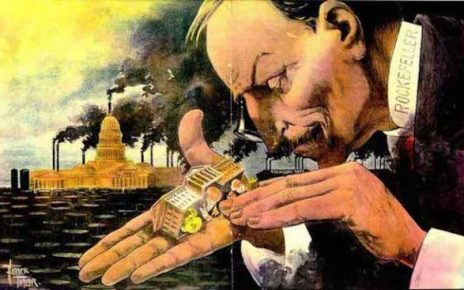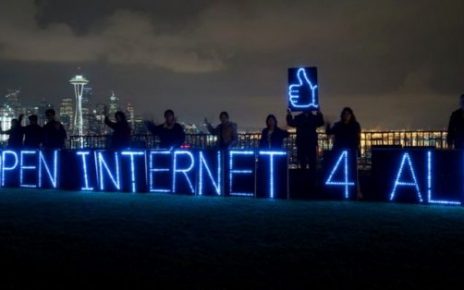On Thursday, North Dakota Governor Jack Dalrymple called on the state’s National Guard to contain contentious protests against the Keystone pipeline, which threatens Native lands and water supplies. The decision comes after private security guards unleashed attack dogs on protesters this weekend, sparking further violence authorities predictably blamed on demonstrators.
A summons of National Guard services usually indicates a growing tide of opposition to government policies and the established order. It is almost always accompanied by inordinate numbers of police officers.
Governors often activate National Guard when violence erupts amid tense societal and political rifts. But while calling in troops may be effective at stopping superficial violence (by threatening or using violence), doing so provides a reliable excuse for the authorities to ignore the original reasons for that “unrest.”
Here are five modern instances of National Guard intervention in domestic affairs and what these historical examples mean for North Dakota:
1. The Race Riots: During the 1960s, waves of protest swept the United States for a variety of reasons. The most prominent riots erupted largely due to African-American frustrations with institutionalized racism, from economic inequality to police injustice. The riots were almost always at least partially inspired by relations with police, if not sparked directly by incidents of police abuse. In cities across the country, governments relied on armies of cops and the activation of thousands of National Guardsmen to shut down waves of often violent protest and looting.
Further, following the assassination of Dr. Martin Luther King in 1968 — which the FBI may have assisted — black Americans were outraged and rioted again. This prompted the activation of multiple state National Guards and amounted to thousands of troops per city, including Baltimore, Chicago, and Washington, D.C.
More recently, National Guard troops were called into Ferguson and Baltimore amid recent protests against police brutality.
2. The Anti-War Movement: In 1968, the trend of dissent against the State continued. This time, it was against the Vietnam War. The National Guard was activated in Chicago, Illinois to shut down protests at the Democratic National Convention, where scorned President Lyndon B. Johnson chose not to seek re-election. Protesters (and eventually, rioters), were discontent with the corruption and warmongering of the leftist faction of the two-party system and thousands took to the streets. In addition to thousands of police officers who instigated violence, the National Guard helped to put down the unrest and break up the protests.
When that proved, unsurprisingly, to be a short-term solution, protests continued. Three years later at Kent State University, Ohio Governor James Rhodes found it appropriate to summon nearly 1,000 National Guardsmen at yet another protest against the ongoing Vietnam War. In the now notorious stand-off, four university students were murdered by the National Guard in their effort to ‘keep the peace’ at a protest for peace. Eight more were wounded. The Guard claimed they were returning fire, but no evidence supported that claim.
3. The Rodney King Riots: In April of 1992, police officers were acquitted of the brutal 1991 beating of intoxicated black motorist Rodney King in northern Los Angeles. The verdict defied video evidence and riots broke out across Los Angeles. Nearly 10,000 National Guard troops were summoned to stop the riots and looting. This proved that the government’s tactic of sending in troops to stop violent protests (precipitated by violence and racism by the government) as it had in the 1960s had failed. It also proved that the state refused to learn its lesson.
4. Waco, TX and the Branch Davidians: When the Alcohol, Tobacco and Firearms division learned that David Koresh, leader of the religious sect, Branch Davidian, was allegedly harboring illegal weapons, they attempted to raid his facility in Waco, TX. This led to deaths on both sides and the FBI’s entry into the conflict. After 51 days, the larger, infamous raid ensued. Though small in number, the National Guard was called in to back up the federal government. Shortly after, Koresh’s compound was set on fire and 80 people died, including women and children.
Though the government’s official story is that the Davidians themselves started the blaze, controversy and distrust of this narrative still run rampant. Koresh and his followers may have been insane and engaged in illicit activity, but the conduct of the FBI and outcome of the 1993 raid is still angrily disputed. The massive show of force is not.
5. The Afghanistan and Iraq Wars: Due to the difficulties and complexities of waging illegal, profit-motivated wars in the Middle East, increasing numbers of domestic troops were needed to waste the wares of military-industrial profiteers. In 2011, nearly half of all troops in Bush’s and Obama’s wars were National Guard. The use of the Guard in foreign wars exposes their true nature: though they may sometimes help during storms and were used to protect the desegregation of schools — after being used to block it — it remains that they are factions of the military.
Clearly, governments have a tendency to call in the National Guard when “order” is disturbed.
Even more so, the National Guard is deemed necessary when the people revolt against oppressive treatment from government. Though riots and violence are never preferable, calling in the National Guard to treat symptoms of underlying abuse is like prescribing pills to treat disease without examining diet, lifestyle, or other contributing factors(otherwise known as modern western medicine).
But what does the activation of the National Guard mean for the protesting tribes in North Dakota? To an extent, this can be answered with one more historical event — the incident at Wounded Knee. On February 27, 1973, 200 Lakota (Sioux) activists seized the town of Wounded Knee, South Dakota, where the U.S. cavalry slaughtered a group of tribespeople in 1890 when they refused to disarm themselves in a standoff on their land. The 1973 protest came as a result of broken promises and failed treaties. After the National Guard was called in to join federal marshals, gunfire broke out for days, leading to the deaths of two protesters and the paralysis of one federal agent.
On May 8, the Native protesters surrendered, and while the standoff over the pipeline is unlikely to result in gunfire for days on end, the government has come down on the side of the powerful, not the people — just as it did in 1973.
On Friday, a U.S. judge ruled against the Sioux tribe’s request that the court block the pipeline, meaning further demonstrations are inevitable. Though the use of National Guard troops coupled with the court ruling signal ominous outcomes for protesters, it will undoubtedly inspire further impassioned dissent. To their credit, the Department of Justice, the Department of the Interior, and the Department of the Army appeared to side with protesters in a statement issued shortly after the court ruling.
Regardless, as the corporate media ignores and downplays the tense situation, the internet and social media are serving as valuable tools to raise awareness, embolden dissent, and build a global community in support of those standing against the pipeline.
Regardless, calling in troops signals the government has no desire to accommodate the people. Rather, it would prefer to continue perpetuating the problems that led them to summon the Guard in the first place.





